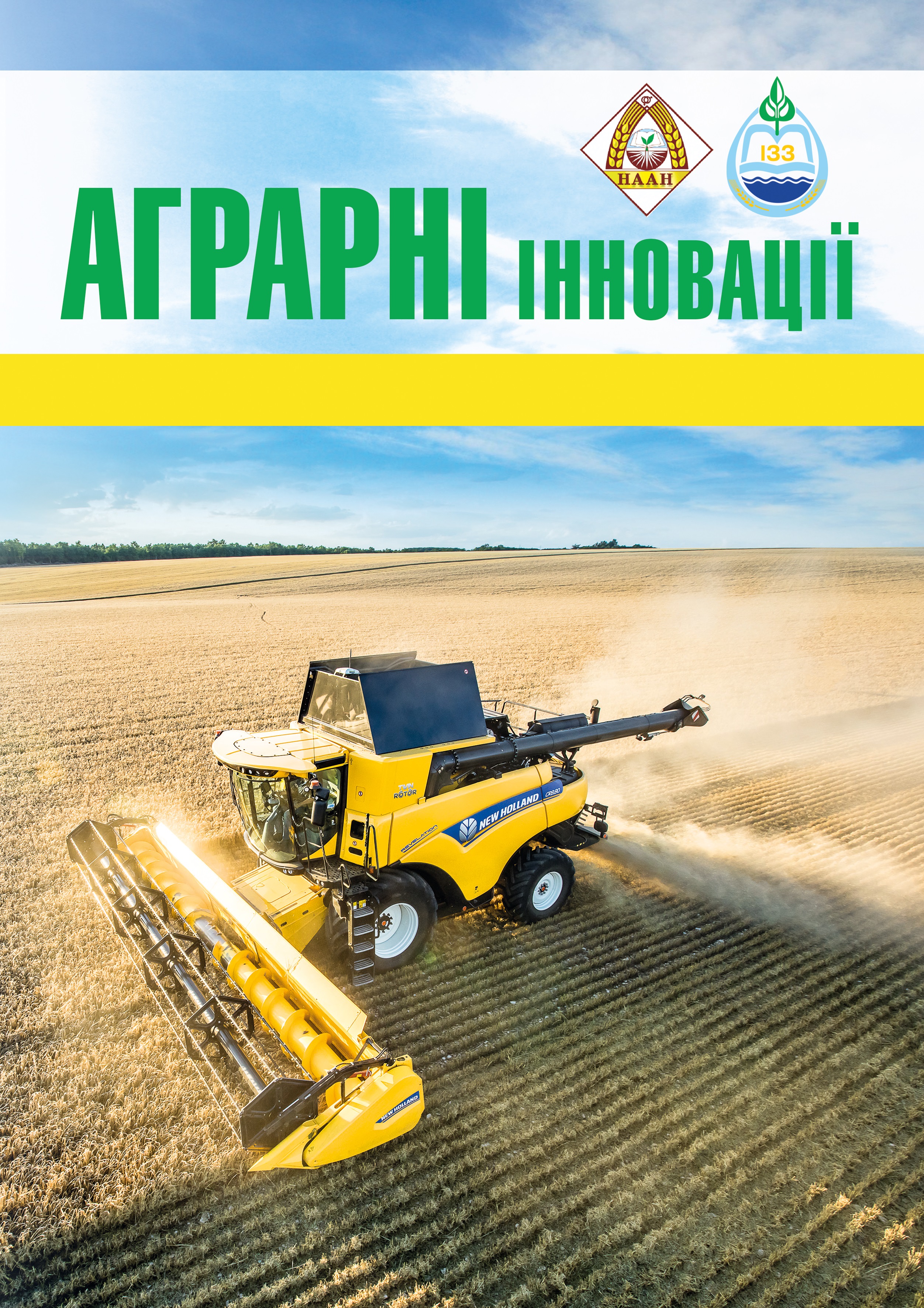Yield capacity and quality of tomato fruits depending on the moisture content of crops on the margins of Ukraine
Abstract
Objective. Determine the yield and quality of fruits depending on the crop regime and fertilization of replanting in the east of Ukraine. Methods. We used general scientific methods: field, laboratory, dimensional, comparative, mathematical-statistical and system analysis. Results. It has been established that the total amount of water supply for tomato roselin for the sign of irrigation for 70% lowest moisture content of the warehouse is 3017.6–3036.6 m3 / ha. On dilyankas, for the introduction of mineral goodness, the total water supply increased by 15.6 m3 / ha, for organic goodness – by 19.0 m3 / ha. For the value of irrigation for 80% of the total water supply is 3082.1–3087.3 m3 / ha. The options for mineral fertilization, the total water supply is less than the inconveniences of the options by 3.0 m3 / ha, for the introduction of the biological product Bioproferm – by 5.2 m3 / ha. For the third regime, the growth of water with the RPVG is 90% of the total water recovery in the most – 3107.7– 3124.4 m3 / ha. For mineral fertilization, change in proportion to the inconvenient option to become 16.7 m3 / ha, for the introduction of bio-fertilization – 7.1 m3 / ha. The research revealed that the organic preparation Bioproferm (6 tons/ha) and vegetative irrigation according to the 80% of chlorine per hectare increase the yield of marketable fruits by 46.1 t/ha, The application of mineral nutrients N108P101K72 equal to the dose of organic nutrients, the plant productivity was higher by 44.7 t / ha compared with un watered and unfertilized control. The highest yield (79.5 t/ha) provided the variant for LLDP at 80% lowest moisture content and application of organic additive Bioproferm, which by 49.1 t / ha exceeded the control variant. The different deposition regimes reduced the content of wet dry matter by 0.9%. Conclusions. The application of fertiliser significantly increases the fruit yield when using drip irrigation in tomato seedless cultivation. When the pre-irrigation moisture is maintained at 80% lowest moisture content and the organic fertiliser Bioproferm is applied, the highest yields of marketable fruit were observed. The combination of optimal regime of cultivation and organically biofortified allows to obtain fruits with high indicators of quality for the industrial type varieties, namely, the content of dissolved solids at levels of 5.2–5.7%.
References
2. Вожегова Р.А., Біляєва І.М., Коковіхін С.В. Інноваційні напрями розвитку зрошуваних меліорацій в умовах Південного Степу України. Таврійський науковий вісник. Сільськогосподарські науки. 2016. Вип. 96. С. 31–40.
3. Могильна О.М., Рудь В.П., Терьохіна Л.А., Урюпіна Л.М., Стовбір О.П., Сидора В.В. Зональне розміщення виробництва томата в Україні. Овочівництво і баштанництво. 2020. Вип. 67. С. 87–100.
4. Groups and livestock products. FAOSTAT. URL: http://www.fao.org/faostat/en/#data
5. Книш В., Наумов А. Безрозсадна технологія вирощування томата за краплинного зрошення. Овощеводство. Київ : Юнівест Медіа, 2017. № 2. С. 24–28.
6. Marouelli W.A., Lage D.A.C., Gravina C.S., Miguel M.F. & Souza R.B. Sprinkler and drip irrigation in the organic tomato for single crops and when inter cropped with coriander. Revista Ciênci aAgronômica. 2013. 44(4), 825–833. URL: https://doi.org/10.1590/S1806-66902013000400020
7. Макрушин М.М., Макрушина Є.М., Петерсон Н.В., Мельников В.В. Фізіологія рослин. Вінниця : Нова книга, 2006. 413 с.
8. Васюта В.В. Сумарне водоспоживання та випаровування томата за різних способів поливу та глибини розрахункового шару ґрунту в південному регіоні України. Вісник аграрної науки. 2015. 93(1). С. 61–66.
9. Liu K., Zhang T.Q. & Tan C.S. Responses of Fruit Yield and Quality of Processing Tomato tfnd Fertilizers to Drip Irrigation of Phosphorus and Potassium. J. Soil Fert. & Crop, Nutr. № 103(5). Р. 1339–1345. https://doi.org/10.2134/agronj2011.0111
10. Ахмедова П.М., Алилов М.М. Особенности минерального питания растений томата при капельном орошении в условиях открытого грунта. Овощи России. 2017. № 1. С. 46–49. URL: https://doi.org/10.18619/2072-9146-2017-1-46-49/
11. Біотехнологія різосфери овочевих рослин : монографія / За ред. В.П. Патики. Вінниця : ПП «ТД Едельвейс і К», 2015. 266 с.
12. Коломоєць Ю.В., Григорюк І.П., Буценко Л.М. Індикуючий вплив біодобрив на продуктивність рослин томатів і формування мікробіоти різосфери. Агроекологічний журнал. 2017. № 1. С. 75–82.
13. Васюта В.В., Косенко Н.П., Степанов Ю.О., Люта Ю.О. Технологія вирощування насінників томата на зрошенні: методичні рекомендації. Центр наукового забезпечення АПВ в Херсонській області. Херсон : ВЦ ІЗПР, 2010. 20 с.
14. Бондаренко Г.Л., Яковенко К.І. Методика дослідної справи в овочівництва і баштанництві. [3-е вид.]. Харків : Основа, 2001. 369 с.
15. Методика польових і лабораторних досліджень на зрошуваних землях / За ред. Р.А. Вожегової. Херсон : Грінь Д.С., 2014. 286 с.
16. Ушкаренко В.О., Вожегова Р.А., Голобородько С.П., Коковіхін С.В. Статистичний аналіз результатів польових дослідів в землеробстві. Херсон : Айлант, 2013. 378 с.






